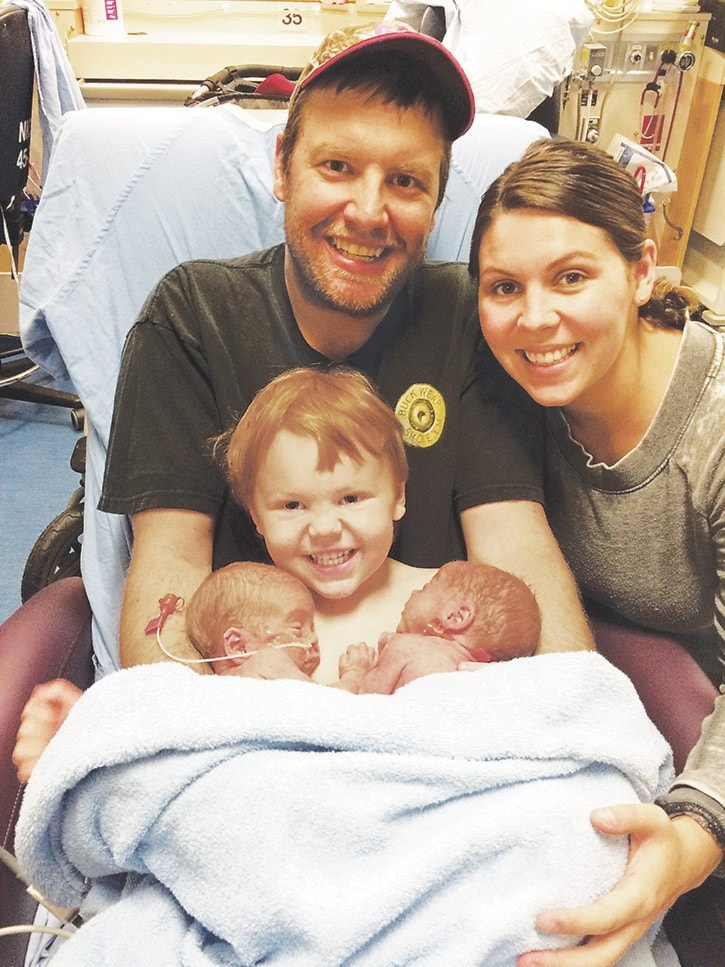A set of twins who shared an amniotic sac and placenta during gestation arrived safely for a Horsefly couple on May 31.
Camden Ronald Shane Goodvin and his brother, Courtlen Gregory Jay, were delivered at Women’s Hospital in Vancouver by emergency C-section at 31 weeks gestation, said their mom Shelby Goodvin.
“They emerged into the world within a minute of one another, weighing three pounds and 11 ounces each. Camden weighed 10 grams more than Courtlen.”
The twins will probably remain in hospital until their original due date of July 30, she added.
Part way through the pregnancy Shelby and her husband Greg learned they were expecting mono-mono twins, technically known as Monoamniotic-Monochorionic.
Mono-mono twins are extremely rare because they share one placenta and amniotic sac throughout the pregnancy, although each twin does have its own umbilical cord.
Normally twins are already at risk for usual complications such as prematurity, diabetes and high blood pressure, but for mono-mono twins there are added risks.
“Because they live in the same sac they are at risk of wrapping their umbilical cords around each other and having a still birth,” Dr. Ken Lim, division head of maternal medicine at UBC and B.C. Women’s Hospital in Vancouver told the Tribune in a previous interview about the Goodvins’ pregnancy.
At the end of April the Goodvins and their two-year-old son Holden went to Vancouver to stay in Ronald MacDonald House so the babies’ heart rates could be monitored two times a day for accelerations or decelerations.
“Decelerations (decels) occur occasionally from temporarily laying on or bumping their chords but should recover quickly,” Shelby said. “We were looking for decels that occurred regularly and took longer to recover. Those kinds of decels would indicate chord compression.”
Each test took anywhere from 20 minutes to a couple of hours depending on how easily the boys’ heart rates were found, how much they moved and if they had any decels they would have to do another test in 20 minutes or so to see if it was just a random bump of the chord or compression.
Every second day Shelby would also have a Doppler ultrasound which listened to the blood flow in the umbilical chords.
“They were looking for resistance in flow, which would again indicate chord compression,” Shelby said. “Every second week we would also have a growth ultrasound to measure the boys’ growth and look for any signs of delayed growth.”
All of the ultrasounds went great and the boys consistently measured the same size and were average weights for a singleton baby, Shelby added.
Initially the plan was to try and deliver them at 32 weeks. Then on May 31 during the morning non-stress test they saw the first indications of chord compression.
“It was decided since we were so close to the goal of 32 weeks they would be delivered that day as soon as an operating room became available,” Shelby said.
Greg and Holden will stay with Shelby until the babies are ready to return home, an arrangement Shelby said was made possible because of generous local support.
Holden is enjoying being a big brother and calls the twins “baby Camden” and “baby Cotin.”
“He also says that they are Holden’s babies and has told the nurses not to look at his babies,” Shelby said.
As soon as she could feel the twins moving, Shelby was adamant they remain “Baby A” and “Baby B.”
“I felt like they already had personalities in utero and I wanted to know who was who once they were out,” she said. “Baby A — Camden was not as busy as Baby B — Courtlen.”
So far Courtlen is busy passing milestones as quickly as possible while Camden is taking his time, she said, noting they barely cry and she has only heard them cry at birth.
“They are very relaxed and the nurses always comment on their good temperament,” she said, adding Holden was the same way as a baby.
Mono mono twins are one per cent of all twin pregnancies, Lim said.
The twin rate varies in B.C. from year to year because of in vitro fertilization and other technologies, he added.
There are roughly 40,000 to 45,000 deliveries in B.C. a year and about 1,000 twin pregnancies, with five to 10 of those being mono -mono twins.
“We see one to three in our hospital because other places manage them,” Lim said.
